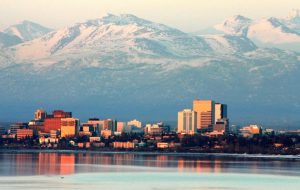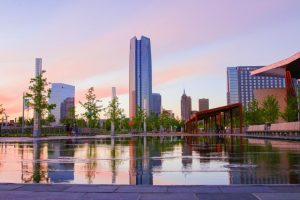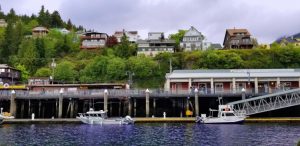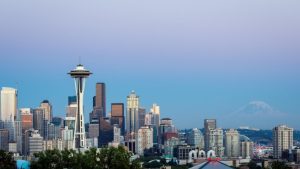 Alaska : Safety by City
Alaska : Safety by City
United States - safety as a country Alaska is such a large state that if you saw one million acres per day, it would take you over a year to see everything!
With a population of over 300,000 inhabitants, Anchorage is by far the largest city in a state with just 730,000 people.
In addition to the countless outdoor activities in the state, visitors can walk through the Alaska Native Heritage Center to better understand traditional dances and crafts, as well as experience copies of residences erected by local Aleuts, Eskimo, and Indian tribes.
Anchorage is typically the starting point for any traveler to the state with many nearby mountains and undeveloped sections such as Talkeetna, Kenai, and Chugach.
In these areas, you will contact nature and probably see moose and bears but will also have the chance to ride a dog sled or admire the Northern Lights.
Alaska is a jewel of the Western Hemisphere with amazing natural diversity and picturesque landscapes that cannot be missed.
If you are considering traveling to the state, it is important to understand the safety requirements and what to look out for during your trip.
Warnings & Dangers in Alaska

OVERALL RISK: MEDIUM
Alaska is the ideal location for an outdoor adventure, but you must understand how to deal with different natural disasters that may occur while visiting. From tsunamis to bears, the biggest uncontrolled risks to travelers occur in the great outdoors when a man can clash with various aspects of nature. Also, Anchorage has a decently high crime index related to drugs which increases the risk to medium. Like in any location, keep your wits about you and do not approach or feed any wildlife you see since the animals are wild.

TRANSPORT & TAXIS RISK: LOW
Using public transport in Alaskan cities is safe. While you should monitor your pockets as pickpockets are possible on crowded vehicles, it is uncommon. All taxis are secure, including those hailed from the street. Ridesharing is also available like in most other U.S. cities but may be less common in the more rural towns and villages.

PICKPOCKETS RISK: LOW
Overall, pickpocketing in any city in Alaska is low. The only time this could occur is on crowded mass transit or in crowded tourist areas. Usually, the pickpockets are those using the money to purchase drugs. Be aware of your surroundings and always keep valuables within your field of vision.

NATURAL DISASTERS RISK: MEDIUM
Winters in Alaska are incredibly cold and snowy with the weather changing at the drop of a hat. Therefore, pack gloves, a hat, and thick clothing, even if planning to spend a small amount of time outside. In the summer, the days are long and can be hot so pack accordingly. Alaska is subject to earthquakes and tsunamis because of its location on the Pacific Rim. Additionally, bears are common and they’re dangerous so never go near them or their cubs or make sudden movements.

MUGGING RISK: HIGH
Due to the drug gangs operating in Anchorage, the risk of armed robbery is high. However, in the smaller towns and cities, this is not a problem. That means you should avoid wandering the city late at night, especially in the most dangerous areas of Anchorage. If you are attacked, give the muggers what they want and contact the police immediately.

TERRORISM RISK: LOW
A considerable terrorist attack on Anchorage is highly unlikely but you should be aware of your surroundings. If you feel uncomfortable or if something seems off, then move or leave the area. Also, be mindful of federal threat levels and never leave luggage unattended.

SCAMS RISK: MEDIUM
Fraud is most actioned in Alaska by email in an illegal attempt to extract sensitive data. Tourists will most likely not encounter any scams. If you are a visitor and concerned with scamming at ATMs then only use bank-based machines.

WOMEN TRAVELERS RISK: LOW
All Alaskan cities are safe for solo women travelers. This does not mean you should leave your common sense on the plane. Use the normal precautions of not staying on the streets late at night and alone or wandering into dangerous neighborhoods. Otherwise, there will not be any issues for women visiting this state.

TAP WATER RISK: LOW
Alaska is full of excellent drinking water with minimal risk of contamination and sickness. Even in small towns and villages, potable water is available given the clean and natural surroundings. Always evaluate every water source and be prepared to filter it if necessary or purchase bottled water if there is a concern.
Safest Places to Visit in Alaska
While Alaska is a fairly safe place to visit, the five safest cities (2021) are Unalaska, Sitka, Homer, Palmer, and Soldotna.
Only 34% of Alaska residents are concerned that crime could occur daily with most Alaskans being worried about package theft.
All the most popular tourist destinations in Alaska are safe places to visit.
These include Denali National Park, Kenai Fjords National Park, the Alaska Highway, Tracy Arm Fjord, the Alaska Native Heritage Center, Inside Passage, and the University of Alaska Museum of the North.
When out in the wilderness at any of the state parks, it is critical to remain on the trails and register with the ranger’s office in case you get lost.
You also never want to feed or approach the wildlife since they are wild animals, and you don’t know how they’ll react.
Generally, use common sense and if something doesn’t feel right then it probably isn’t, and you should leave immediately.
Places to Avoid in Alaska
While scams, pickpocketing, muggings, and violent crimes can occur anywhere in the state, you are unlikely to have any problems in the smaller cities, towns, and villages.
Anchorage is considered a major city in Alaska and has many drug gangs.
Therefore, certain areas in the northeast section of the city, specifically Mountain View, north of the Glenn Highway and east of Merrill Field airport, central around Fairview, 6th to 15th Avenue, and east of Ingra, have the highest crime rate in the city.
There is nothing for tourists to visit in these areas so there is no reason to go there.
Also, when traveling anywhere in Anchorage, never leave valuables in your vehicle, always lock it, and park in guarded parking lots since car break-ins and theft are common.
While camping in the forests and mountains are safe, stick to the state-recognized campsites and don’t go too far off the beaten path.
There are many wildlife and weather dangers you could be exposed to, especially if you venture out alone.
Safety Tips for Traveling to Alaska
With its enormous size and distinct tourist scene, Alaska provides an exclusive set of obstacles and pitfalls that can ruin your trip or be incredibly dangerous.
Therefore, the following is a list of the top 10 safety tips for traveling to Alaska, including:
- Avoid unsafe areas. When in Anchorage, always check the areas to avoid and do not venture into them during the day or especially at night. The drug issues in the city could make you the victim of a crime.
- Check the weather report before hiking or camping. The weather in Alaska can change at the drop of a hat so it’s important to always check the forecast before hiking into the wilderness. There have been countless incidences over the years where tourists have gone missing in the wild and have never been found. If a squall hits during the winter, you could be snowed into the area or be subjected to an avalanche for weeks
- Covering too much ground in too little time. With Alaska being such a massive state, there is a lot to see. To put it in perspective, it’s a five-hour drive from Anchorage to Denali alone. Many visitors attempt to cover too much ground in too little time, which can leave you exhausted. While driving in Alaska is safe, driving around exhausted at night in the wilderness is not. Plan what you want to do and see in advance and assign a reasonable amount of time to complete each activity. Also, try to stick to one or two regions for exploration so you can enjoy what you’re seeing and remain safe.
- Don’t approach wildlife. While moose, bears, and other wildlife may appear cute, they have been known to charge and attack humans if they feel threatened. Simply observe and take photos from a distance and never attempt to feed them.
- Don’t leave values in parked cars. Keep all valuable items on you when leaving a parked car, even in monitored garages. Take all items out of sight and lock the car before going to your destination.
- Never show your valuables in public. Like in any city, be mindful of your personal belongings. Due to drug-related crimes in Anchorage, never show money or valuable items in public as you could become a victim of opportunity.
- Never travel into the wilderness alone. Never venture alone into the wild as there are many weather and animal threats. Always have at least one travel buddy and register with the local park ranger’s office to give them an idea of where you are headed.
- Pack different clothes for different weather types. Since the weather can change rapidly, you want to be prepared for all types whether out hiking or in the city and doing different daily activities.
- Register with the ranger when camping. When taking a hike or going camping for a few days, register with the local ranger’s office so they know where to find you if there is an incident.
- Stick to campsites. Never camp in random, unknown places. You can look online for the best campsites in the area you are visiting or check with the park ranger’s office on safe places to camp. Going off the beaten path is incredibly dangerous due to weather and wild threats.
So... How Safe Is Alaska Really?
Overall, Alaska is a safe place to visit.
However, despite its beauty nestled in the mountains and on the Alaskan coast, Anchorage has a high crime rate.
The primary problems in the city are related to the sale and use of drugs, car and property thefts, and robberies with burglary.
Remember, you are most likely to be the victim of a crime of opportunity, which means if you have money sticking out of your pocket, someone could pickpocket you.
Most reported violent crimes in Anchorage are related to domestic disputes.
Outside of Anchorage in the wilderness, stay away from bears, cubs, and moose.
While some animals may appear to be harmless, they will protect their young from people, and moose can charge when feeling threatened or cornered.
All wildlife is best viewed from a distance to ensure your safety while still feeling connected with nature.
If you follow the general security measures offered by park rangers and the government, do not mess with drug dealers or other shady characters, do not wander in bad neighborhoods alone at night, you will not encounter any problems when visiting Alaska.
The overall risk of visiting this state is low.
How Does Alaska Compare?
| State | Safety Index |
|---|---|
| Alaska | 65 |
| Kansas | 81 |
| Iowa | 82 |
| Idaho | 85 |
| Illinois | 77 |
| Indiana | 61 |
| Colorado | 82 |
| Florida | 70 |
| Maryland | 65 |
Useful Information

Visas
Given that Alaska is in the United States, a visa is not required for U.S. citizens and normal visas per country are required for foreign travelers. U.S. citizens require their normal government-issued identification card for flights, cruises, or train rides. Note, train rides from the Pacific Northwest travel through Canada so you must understand the transfer requirements when traveling through.

Currency
Like the rest of America, the United States dollar is the main currency. In major cities, you can use Visa, Mastercard, AMEX, and Discover cards, and ATMs are plentiful. In smaller towns, many retailers, bars, and restaurants are cash-only, so it’s best to have some cash on hand.

Weather
Most tourists visit Alaska between June and September due to the milder weather without snow. Given the size of the state, the average temperatures vary so it is important to pack accordingly. When considering humidity, temperatures feel mild-to-cold throughout the year but areas in the southern portion of the state can become hot in July and August, so sunscreen could be required.

Airports
While there are many small airports throughout the state, Ted Stevens Anchorage International Airport is the largest and most used. Located only five miles southwest of downtown Anchorage, ANC serves around fifty destinations via nonstop flights, including locations in 14 U.S. states and Russia, Iceland, Germany, and Canada.

Travel Insurance
While Alaska may feel like a foreign country to many Americans, it is still a U.S. state. That means your regular insurance will cover you in the event of an accident. However, given the dangers found in the great outdoors, it is beneficial to get extra insurance for your trip in case of an airlift requirement or other incredibly expensive procedure that your regular insurance may not cover.
Alaska Weather Averages (Temperatures)
Average High/Low Temperature
| Temperature / Month | Jan | Feb | Mar | Apr | May | Jun | Jul | Aug | Sep | Oct | Nov | Dec |
|---|---|---|---|---|---|---|---|---|---|---|---|---|
| High °C | 2 | 3 | 5 | 9 | 13 | 17 | 17 | 17 | 14 | 9 | 5 | 2 |
| Low °C | -3 | -3 | -1 | 2 | 6 | 9 | 11 | 10 | 7 | 4 | 0 | -3 |
| High °F | 36 | 37 | 41 | 48 | 55 | 63 | 63 | 63 | 57 | 48 | 41 | 36 |
| Low °F | 27 | 27 | 30 | 36 | 43 | 48 | 52 | 50 | 45 | 39 | 32 | 27 |
Alaska - Safety by City
| City | Safety Index |
|---|---|
| Anchorage | 72 |
| Fairbanks | 65 |
| Juneau | 88 |
| Ketchikan | 94 |
| Seward | 92 |
| Sitka | 91 |












Accurate article
As a resident of Anchorage, AK I think this is an excellent article. Alaska has so many amazing places to see.
All the warnings about car theft and break-ins are true. And the biggest safety issue would be at night in the downtown area. Also avoid the other places mentioned here.
Also, do not approach any wildlife no matter how
docile they look. Moose in Anchorage can be more dangerous than bears because they are not afraid of humans.
A note about weather-Alaska tends to be quite rainy. Bring some good quality rain gear so you don’t have to cancel any plans.